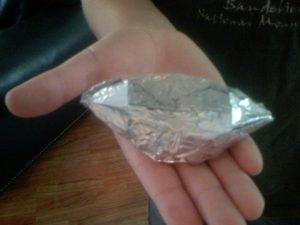 Let one child at a time close their eyes, shake the container near one ear, the other ear, or at the neck of the child. Ask the child to tell you where the sound came from!
It is important that the rest of the group of children is as quiet as they can when performing this experiment, otherwise it will be difficult to hear the Sound!
Is sound heard everywhere?
Sound is conducted differently in different materials. That sound is heard even under water, you learn that when you dare to have your ears below the water surface, but that phenomenon can also be detected through a plastic container.
Ask the children (one at a time) to put one ear against a wooden object, and hold the other ear shut. Tap the wooden object lightly with the pen. Can it be heard? Continue with the other materials.
The children who dare, can lower their ears below the water surface in the pool if you bathe, then you tap with the pen against the pool edge.
Let one child at a time close their eyes, shake the container near one ear, the other ear, or at the neck of the child. Ask the child to tell you where the sound came from!
It is important that the rest of the group of children is as quiet as they can when performing this experiment, otherwise it will be difficult to hear the Sound!
Is sound heard everywhere?
Sound is conducted differently in different materials. That sound is heard even under water, you learn that when you dare to have your ears below the water surface, but that phenomenon can also be detected through a plastic container.
Ask the children (one at a time) to put one ear against a wooden object, and hold the other ear shut. Tap the wooden object lightly with the pen. Can it be heard? Continue with the other materials.
The children who dare, can lower their ears below the water surface in the pool if you bathe, then you tap with the pen against the pool edge.
Kategori: English
Build a Sound-Memory
Material
- A number of cans or containers that do not have to be the same. Film cans, plastic drawers, the small containers that are inside chocolate eggs, pipes that have been effervescent tablets.
- Things to fill the jars with: popcorn, dry white beans, rice, sand, sugar cubes, screws, gravel, nuts, eraser pieces, etc.
Remember to ”listen off” to the sounds so that the different things do not sound too similar.
Game Rules:
- Place the different containers on the table.
- Decide who will start the game.
- Each player may try two containers at a time.
- If the sound sounds alike, the player can take the containers as a pair.
Most sound-pairs win!
Game variant:
Bring an odd container, with an odd sound, and play with it as a ”Joker”. Is it really the container with the odd sound in it that is left over at the end?
It can be an advantage if the containers can be opened when the game is over, to see if there really were similar things inside. The sounds will be different if you put popcorn in a plastic container or in a paper box, for example.
Foil boat challenge
 Your challenge is to build a boat that can hold the most small coins before it sinks.
Your challenge is to build a boat that can hold the most small coins before it sinks.
YOU WILL NEED:
- Large bowl of water
- 30 plus small coins per boat
- Aluminum Foil
HOW TO SET UP YOUR BUOYANCY EXPERIMENT
- Fill your bowl to 3/4 with water.
- Cut two 8″ squares of aluminum foil for each boat. Then form a small boat from the aluminium foil of one of them .
- Place 15 coins on the other square of tin foil (not the boat) and have the kids ball it up and place it in the water. What happens? (It sinks!)
- Place your boat in the water and see if it floats. Reshape if it doesn’t! Then slowly add the coins one at a time. How many pennies can you count before it sinks?
- Extend the challenge by rebuilding your boat to see if it can hold even more pennies.
Scientific Explanation:
You are in this experiment working with Archimede Principle – The lifting force of the water is always as great as the weight of the water that the object in the water displaces.
This experiment came from LittleBinsLittleHands.
Forms of Expression for Natural Science
 The Swedish National Agency for Education (Skolverket) has a good article about different ways of communicating about and documenting scientific experiences.
The Swedish National Agency for Education (Skolverket) has a good article about different ways of communicating about and documenting scientific experiences.
The article gives down-to-earth tips on how to present what you come up with in different ways, for example as a photo book (Book Creator works well for that), or make a blog (maybe try AudioMemos to create and SoundCloud to upload). Or why not do an advertising campaign (maybe use Pupet Pals to make small movies, or iMotion if you want to use green-screen technology). Or maybe even a blog? (Easy to do on Pedanet, or WordPress)
Working with learning through a presentation deepens the thinking about what they have learned and anchors it better in the memory, that you can also connect a little digital technology makes it a more exciting and develops their abilities in the digital field.
I recommend that you take a look at ”Expression forms for Discoverers” on the National Agency for Education’s page. (Note: the article is in Swedish.)
Stargazing in the daytime
Then you can take advantage of the SkyView Lite app that shows where the constellations should appear if it was dark. It is displayed on top of the image the camera takes from real sky in what is called augmented reality.
The app can be found here: https://blog.edu.turku.fi/iktpedagogik/2020/07/02/skyview-lite/
Create Your Own Underwater Vulcanoe
What you need to do your own underwater vulcanoe is (maybe not as good looking as the real Hawaiian below):
- A large container
- A glass / small vase / beaker, preferably with a small neck or collar for easier attachment of threads
- Yarn / string or steel wire
- Water
- Food Colour
Tie the cord / steel wire into the collar of the small container. In the large container you pour cold water. In the glass / vase / beaker you pour as hot water as you can (think of the risk of explosion with boiling water in glass!) And color the warm water with the food colour. Immerse the small beaker in the large container and see what happens!
The hot water is lighter than the cold water, and therefore wants up to the surface to lie there. It flows out of the smaller beaker to reach the top of the large container.

Baking soda rocket
 Now that the weather is getting a little warmer, it can be fun to experiment a bit with water. In this case, build a rocket.
Now that the weather is getting a little warmer, it can be fun to experiment a bit with water. In this case, build a rocket.
What you need is:
- Film jar (or similar jar with snap cap)
- Baking soda
- Water
Quickly snap on the lid, shake once, set it upside down and take a step back.Explanation
Baking powder consists of about 30% bicarbonate, 40% some acid (eg sodium pyrophosphate) and 30% moisture resistant substance (eg corn starch). The baking powder reacts with itself when it comes into contact with water – bicarbonate and acid react to form a salt (which depends on the acid) as well as carbon dioxide.
The carbon dioxide is in gaseous form, which means it takes up a lot of space. The more carbon dioxide that is formed, the more pressure inside the film can increase (this high pressure is due to the fact that the carbon dioxide molecules are forced on a small volume while they collide a lot with each other and the film can walls). When the pressure becomes sufficiently large, the carbon dioxide molecules shoot out of the film can, while the lid flies off and the film can lift.
Experiment
To make this study an experiment, try answering one of the following
issues. Don’t forget to make a hypothesis and explain the result.
Will the rocket become more powerful if you use hot water?
Will the rocket become more powerful if you use more water?
Will the rocket become more powerful if you use more baking powder?
Will the rocket become more powerful if you use a larger jar with a lid, as well as more water and baking powder?
Variants
- It is possible to make a launch pad by attaching an empty towel roll to a rigid paper, and then placing the film can in the towel roll.
- It is also possible to mix baking powder and water in a tightly sealed bag and see how the bag expands (and possibly cracks).
- Instead of baking powder, you can use some type of effervescent tablet, e.g. Samarin or a vitamin C tablet. These also usually contain bicarbonate and some acid.
- Even more powerful is the reaction if you pour vinegar into water instead of water.
Thank you to the Experiment Café in Sigtuna for this experiment.
Fun with air
A bit of fun with air, balloons and cotton balls.
- Balloon Sneak
Place a balloon at one end of the room and sneak up against it. 0m the balloon moves out of the air in the room, you must back until the balloon is still standing, before you can start sneaking on it again. Anyone who reaches the balloon may place it in a new place, so you sneak on! - Where does the air go when you blow?
Blowing on a spout of paper or cotton shows how the air gets a direction when pressed out of the mouth through the lips. It is possible to control the direction if you train a little, by blowing from different directions and by moving the hole between the lips. It is also possible to control how far between should come by blowing different hard. Just try it out! To further develop the blowing, you can use straws of various kinds, thin and thick, those that can be angled and those that are straight and the nice squeaky straws can not be forgotten!
For the more competitive, there are many variants to try. For starters, you can have each to blow and blow one blow each and see who comes closest to the center! A further development of this is to see how many blows each person needs to reach the midpoint. Then you should have decided from the beginning what is the matter, is it a matter of coping with as few blows as possible, or is it about blowing as gently as you can, and thereby getting many blows? Of course, you can also compete by blowing towards the other’s tussle to prevent it from reaching the nest. Admittedly, it becomes more blow hockey than curling, but it’s also fun! If you want to play blow hockey, the thick straws that are led and can bend like a hockey club are usually best. Small targets can be made by placing two stones at a certain distance from each other.
Cloud in a Can
 Pour hot water into a glass jar. Close the lid and place a plate on the lid on which you put snow or ice.
Pour hot water into a glass jar. Close the lid and place a plate on the lid on which you put snow or ice.
See how the water forms clouds and how the cloud slowly flows down like rain.
Think with the kids how it works.
Where do the clouds come from? Where does the rain come from? Why is it raining down? And on…
Egg Drop Challenge
I like challenges. Do you dare to try this I found from Buggy and Buddy?
The challenge is to create a container that will protect an egg from cracking or breaking from a high fall. You can make this as simple or complex as you want depending on the amount of time you have and the ages of kids you are working with.
Materials for the Egg Drop Challenge
- You can use anything you want!
Procedure
- Come up with an idea of some type of container you can make to protect an egg from a high fall.
- Build your container and place the egg inside.
- Drop the egg from someplace high. (Be sure it’s safe and an adult is with you.)
- After you drop it look and see if your egg cracked or remained intact.
Questions to Spark More Curiosity & Critical Thinking
Describe your design.
- Why do you think it will protect the egg?
- Did it work? Why or why not?
- How could you improve your design?
Want to go even further?
- Try dropping the egg from increasing heights. Does it eventually stop working?
- If your initial design did not work, redesign it and try to improve it. Can you get it work the next time?
- Fill a box with a large amount of materials that could be used for this project. Then allow each child to only choose 3 items from the box to build their design.
